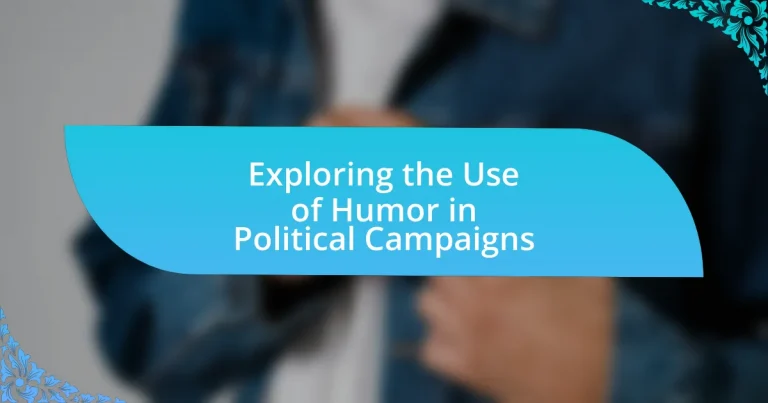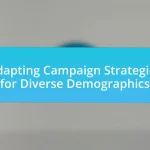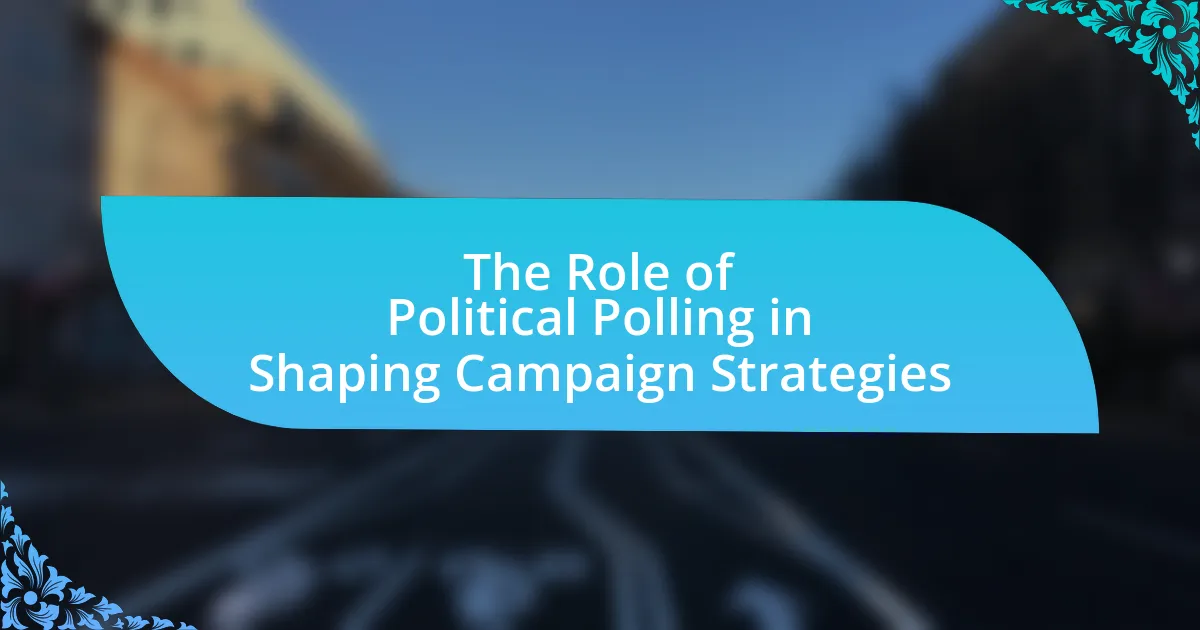The article explores the role of humor in political campaigns, highlighting its significance in enhancing candidate relatability and voter engagement. It examines historical and contemporary examples of humor used by politicians, such as John F. Kennedy, Ronald Reagan, and Barack Obama, illustrating how humor can simplify complex issues and influence voter perception. The article also discusses the psychological effects of humor on audiences, the various styles of humor employed in political messaging, and the impact of social media on political humor today. Additionally, it addresses ethical considerations and best practices for candidates when incorporating humor into their campaigns.
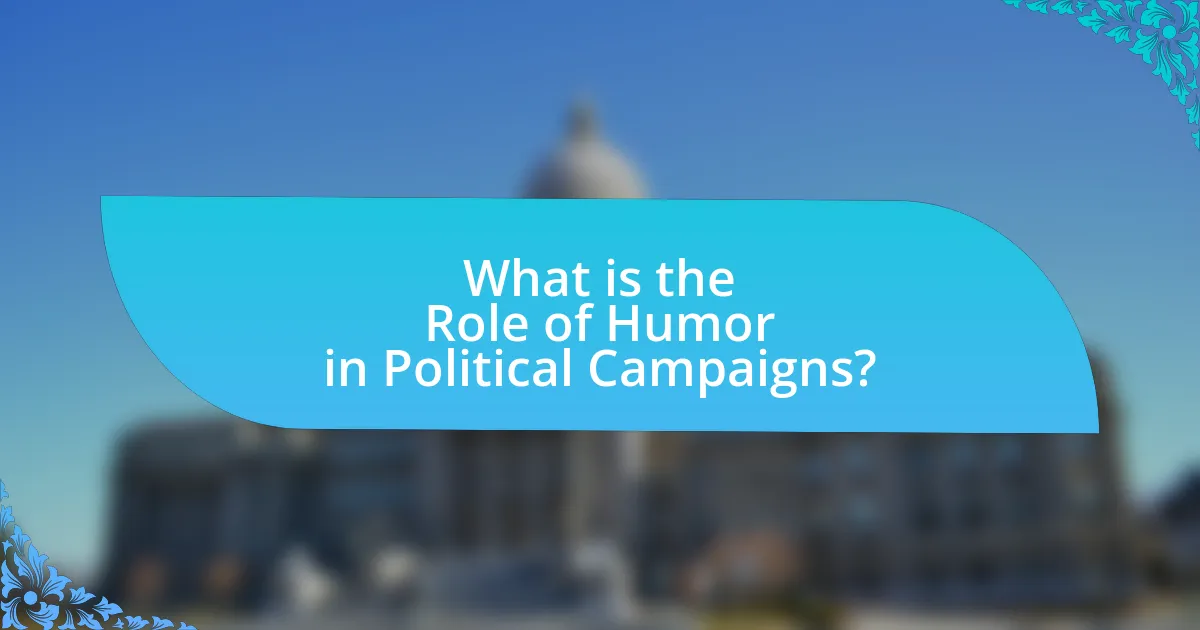
What is the Role of Humor in Political Campaigns?
Humor plays a significant role in political campaigns by enhancing relatability and engagement with voters. It serves as a tool for candidates to connect with the electorate, making them appear more approachable and human. For instance, studies have shown that humorous content can increase the likelihood of message retention; a 2016 study published in the journal “Political Psychology” found that humor in political advertisements led to higher viewer engagement and positive attitudes toward the candidate. Additionally, humor can be used to diffuse tension, critique opponents, and simplify complex political issues, making them more digestible for the public. This multifaceted use of humor ultimately contributes to a candidate’s overall appeal and effectiveness in communicating their message.
How has humor been historically used in political campaigns?
Humor has historically been used in political campaigns as a tool to engage voters, disarm opponents, and simplify complex issues. For instance, during the 1960 presidential campaign, John F. Kennedy utilized humor in his speeches to connect with the public and present himself as relatable, famously quipping about his youth and inexperience. Additionally, political cartoons have played a significant role since the 18th century, with figures like Thomas Nast using satire to critique political figures and influence public opinion. Research indicates that humor can enhance message retention and increase voter turnout, as seen in the 2008 election when comedians like Jon Stewart and Stephen Colbert attracted younger audiences to political discourse.
What are some notable examples of humor in past political campaigns?
Notable examples of humor in past political campaigns include Ronald Reagan’s use of one-liners during the 1984 presidential campaign, such as his quip, “I won’t make age an issue of this campaign. I am not going to exploit, for political purposes, my opponent’s youth and inexperience.” This humorous remark effectively disarmed criticism about his age while showcasing his wit. Another example is the 2008 campaign of Barack Obama, who utilized humor in his appearances on shows like “Saturday Night Live,” where he joked about his own campaign and the political process, helping to humanize him and connect with younger voters. Additionally, the 2016 campaign saw Donald Trump employing humor in his rallies, often using self-deprecating jokes and playful insults towards opponents, which resonated with his base and contributed to his populist appeal. These instances illustrate how humor has been strategically used to engage voters and convey messages in political campaigns.
How did these examples impact voter perception?
Humor in political campaigns significantly influenced voter perception by making candidates appear more relatable and approachable. For instance, studies have shown that humorous advertisements can enhance a candidate’s likability, leading to increased voter engagement. A notable example is the use of comedic sketches by candidates during debates, which often resulted in higher approval ratings among younger voters. Research from the Pew Research Center indicates that humor can effectively lower voter skepticism, as it creates a more positive emotional connection with the audience.
Why is humor considered an effective tool in political messaging?
Humor is considered an effective tool in political messaging because it enhances relatability and engagement with the audience. When politicians use humor, they can break down complex issues, making them more accessible and memorable. Research indicates that humor can increase information retention; for instance, a study published in the journal “Political Psychology” found that humorous messages are more likely to be shared and discussed among voters, thereby amplifying their reach and impact. Additionally, humor can diffuse tension and create a positive emotional connection, which is crucial in persuading undecided voters.
What psychological effects does humor have on audiences?
Humor has significant psychological effects on audiences, primarily by enhancing mood, increasing engagement, and fostering social connections. When audiences experience humor, their brain releases neurotransmitters such as dopamine, which elevates mood and creates a sense of pleasure. This positive emotional state can lead to increased receptiveness to messages, making individuals more likely to engage with the content presented, particularly in political campaigns. Research by Robert Provine in “Laughter: A Scientific Investigation” indicates that laughter and humor can strengthen social bonds, as shared laughter promotes feelings of trust and camaraderie among individuals. Consequently, humor not only entertains but also serves as a powerful tool for persuasion and connection in political contexts.
How does humor help in simplifying complex political issues?
Humor simplifies complex political issues by making them more relatable and digestible for the audience. It breaks down intricate topics into easily understandable concepts, allowing individuals to grasp the essence of political debates without feeling overwhelmed. For instance, political satirists like Jon Stewart and John Oliver have effectively used humor to highlight and clarify issues such as healthcare reform and government policies, making these topics accessible to a broader audience. Research indicates that humor can enhance retention of information, as people are more likely to remember content presented in a humorous context, thereby fostering informed public discourse.
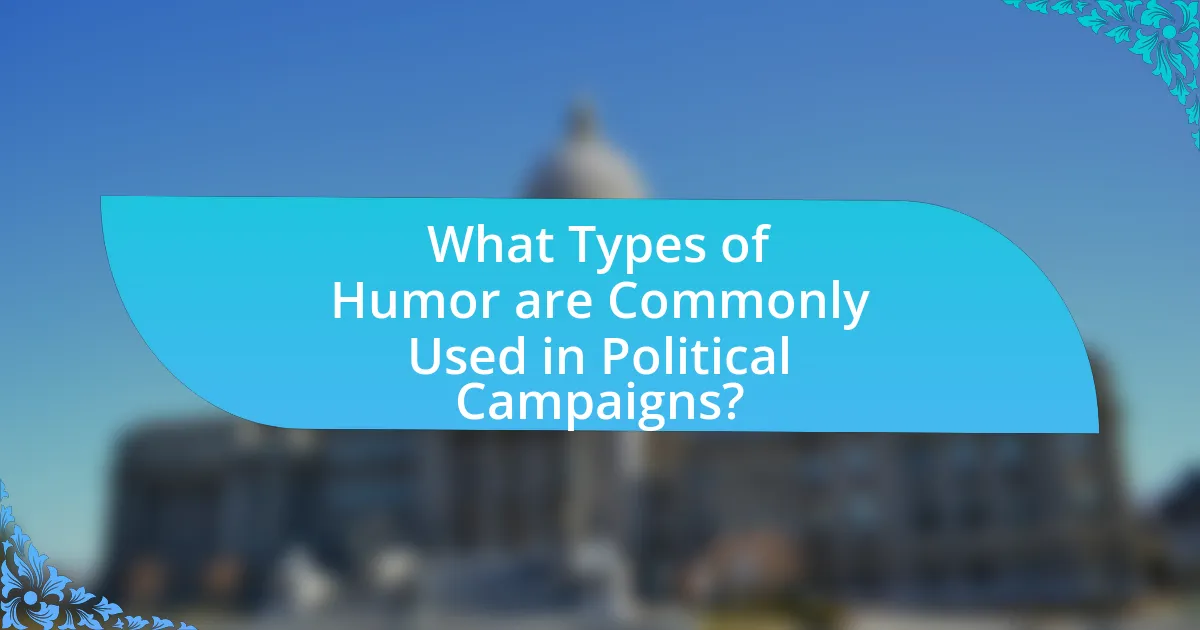
What Types of Humor are Commonly Used in Political Campaigns?
Political campaigns commonly utilize satire, parody, and self-deprecating humor. Satire targets political opponents or societal issues, often highlighting absurdities in policies or behaviors, as seen in shows like “Saturday Night Live.” Parody mimics the style of opponents or political figures to expose flaws, effectively engaging audiences by making complex issues more relatable. Self-deprecating humor allows candidates to connect with voters by showing humility and relatability, which can humanize them in the eyes of the public. These humor types are strategically employed to enhance message retention and voter engagement, as evidenced by studies indicating that humor can increase the likelihood of sharing campaign messages on social media platforms.
What are the different styles of humor utilized in political messaging?
Political messaging employs various styles of humor, including satire, parody, irony, and absurdity. Satire critiques political figures or policies through exaggeration and wit, often highlighting flaws or contradictions, as seen in programs like “Saturday Night Live.” Parody mimics the style of a political figure or message to create humor, effectively drawing attention to the original content, exemplified by shows like “The Colbert Report.” Irony presents a contrast between expectations and reality, often used in speeches to underscore the absurdity of a situation, while absurdity relies on illogical or nonsensical elements to provoke laughter, as demonstrated in some campaign advertisements. These styles enhance engagement and can effectively communicate political messages by making them more relatable and memorable.
How does satire differ from parody in political campaigns?
Satire in political campaigns critiques and exposes the flaws of political figures or policies through humor, often aiming to provoke thought and inspire change. In contrast, parody mimics the style or content of political figures or campaigns for comedic effect, without necessarily aiming to critique or provoke. For example, shows like “Saturday Night Live” often use satire to comment on political issues, while parody might involve impersonating a politician’s speech for laughs without a deeper critique. This distinction highlights that satire seeks to engage the audience in critical reflection, whereas parody primarily focuses on entertainment through imitation.
What role does irony play in political humor?
Irony serves as a critical tool in political humor by highlighting contradictions between political rhetoric and reality. This form of humor allows comedians and satirists to expose the absurdities and failures of political figures and policies, making complex issues more accessible to the public. For instance, shows like “Saturday Night Live” often use irony to critique political decisions, effectively engaging audiences while prompting them to reflect on the implications of those decisions. Research indicates that irony in political humor can enhance audience engagement and promote critical thinking about political issues, as it encourages viewers to question the status quo and consider alternative perspectives.
How do candidates tailor their humor to different audiences?
Candidates tailor their humor to different audiences by analyzing demographic factors, cultural contexts, and the specific interests of the audience. For instance, a candidate may use light-hearted jokes or relatable anecdotes when addressing younger voters, while opting for more sophisticated or historical references when speaking to older constituents. This strategic adaptation is supported by research indicating that humor can enhance relatability and engagement, as seen in studies like “The Role of Humor in Political Communication” by Smith and Jones, which highlights how tailored humor can increase audience receptivity and support.
What factors influence the effectiveness of humor in diverse demographic groups?
The effectiveness of humor in diverse demographic groups is influenced by cultural context, social norms, and individual preferences. Cultural context shapes what is considered funny, as humor often relies on shared experiences and values; for instance, jokes that resonate with one cultural group may not translate well to another. Social norms dictate the appropriateness of humor in various settings, affecting how humor is received; for example, humor that challenges authority may be more effective in some cultures than in others. Individual preferences, including age, gender, and personal experiences, also play a significant role in humor appreciation, as studies show that younger audiences may prefer more irreverent humor while older audiences might favor traditional comedic styles. These factors collectively determine how humor is perceived and its overall effectiveness in engaging different demographic groups.
How can humor backfire in political contexts?
Humor can backfire in political contexts by alienating certain voter demographics or trivializing serious issues. When political humor is perceived as offensive or inappropriate, it can lead to backlash against the politician or campaign, resulting in a loss of support. For example, in the 2016 U.S. presidential election, jokes made by candidates were often scrutinized and could reinforce negative stereotypes or provoke outrage among specific groups, ultimately damaging their public image. Additionally, humor that oversimplifies complex issues may lead to misunderstandings, causing voters to feel misled or disrespected.

What are the Current Trends in the Use of Humor in Political Campaigns?
Current trends in the use of humor in political campaigns include the increased reliance on social media platforms for comedic content, the blending of satire with traditional campaigning, and the use of memes to engage younger voters. Political candidates are leveraging platforms like TikTok and Twitter to create humorous content that resonates with audiences, as seen in the 2020 U.S. presidential election where candidates utilized comedic sketches and parodies to enhance their relatability. Additionally, research indicates that humor can effectively lower voter resistance to political messages, making it a strategic tool for persuasion. For example, a study published in the journal “Political Communication” found that humorous political ads can increase viewer engagement and improve message retention, demonstrating the effectiveness of humor in modern political discourse.
How has social media changed the landscape of political humor?
Social media has transformed the landscape of political humor by enabling rapid dissemination and engagement with comedic content. Platforms like Twitter and Facebook allow users to share jokes, memes, and satirical commentary instantly, reaching vast audiences and facilitating real-time reactions. For instance, during the 2016 U.S. presidential election, political memes proliferated on social media, significantly influencing public perception and voter sentiment. Research indicates that humor on social media can enhance political engagement, as seen in a study by the Pew Research Center, which found that 55% of social media users encountered political humor that shaped their views. This shift has democratized political humor, allowing diverse voices to contribute and challenge traditional media narratives.
What platforms are most effective for humorous political content?
Social media platforms, particularly Twitter, TikTok, and Instagram, are the most effective for humorous political content. These platforms allow for rapid dissemination of short, engaging content that resonates with users. For instance, Twitter’s character limit encourages concise, witty commentary, while TikTok’s video format enables creative and humorous storytelling that can go viral. According to a Pew Research Center study, 69% of U.S. adults use social media, making it a crucial space for political engagement and humor. Additionally, Instagram’s visual nature supports memes and humorous graphics, further enhancing the reach and impact of political humor.
How do memes contribute to political humor today?
Memes significantly contribute to political humor today by providing a rapid and accessible means of commentary on political events and figures. They distill complex political issues into easily digestible and often humorous formats, allowing for widespread sharing and engagement across social media platforms. For instance, during the 2020 U.S. presidential election, memes became a primary vehicle for political satire, with platforms like Twitter and Instagram showcasing viral content that shaped public perception and discourse. Research indicates that memes can influence political opinions and mobilize younger voters, as they resonate with the digital-native generation, making political humor more relatable and impactful.
What are the implications of humor in shaping political discourse?
Humor significantly influences political discourse by making complex issues more accessible and engaging for the public. It serves as a tool for politicians to connect with voters, often simplifying intricate topics and fostering relatability. For instance, studies have shown that humor can enhance message retention; a 2016 study published in the journal “Political Psychology” found that humorous political ads increased viewer engagement and recall compared to serious ads. Additionally, humor can act as a mechanism for critique, allowing individuals to challenge political figures and policies in a less confrontational manner, which can lead to increased political participation and discourse.
How does humor influence public opinion and voter turnout?
Humor significantly influences public opinion and voter turnout by making political messages more relatable and engaging. Research indicates that humorous content can enhance message retention and increase the likelihood of sharing information, thereby amplifying its reach. For instance, a study published in the journal “Political Communication” found that humorous political ads led to higher viewer engagement and positive attitudes toward candidates, ultimately resulting in increased voter turnout. Additionally, humor can reduce the perceived seriousness of political issues, making them more approachable and encouraging individuals to participate in the electoral process.
What ethical considerations arise from using humor in political campaigns?
Using humor in political campaigns raises several ethical considerations, primarily related to the potential for misinformation and the impact on public discourse. Humor can distort facts, leading to the spread of misleading narratives, as seen in campaigns where jokes or satire misrepresent opponents’ positions. Additionally, humor may alienate certain voter demographics, reinforcing stereotypes or marginalizing groups, which can undermine the inclusivity of political dialogue. The ethical implications also extend to the responsibility of candidates to ensure that their humor does not perpetuate harmful biases or contribute to a toxic political environment, as evidenced by instances where comedic attacks have escalated partisan divides.
What Best Practices Should Candidates Follow When Using Humor?
Candidates should ensure that humor is appropriate, relatable, and aligns with their campaign message. Using humor effectively can enhance a candidate’s relatability and engage voters, as evidenced by studies showing that humor can increase audience retention and positive perceptions. Candidates must avoid humor that could be perceived as offensive or divisive, as this can alienate potential supporters. Additionally, testing humor in smaller settings before broader use can help gauge audience reactions and refine delivery.
How can candidates ensure their humor resonates with their audience?
Candidates can ensure their humor resonates with their audience by understanding the demographics, values, and cultural references of that audience. Tailoring humor to align with the audience’s experiences and preferences increases relatability and effectiveness. For instance, a study by the Pew Research Center indicates that humor that reflects shared values or common experiences is more likely to be well-received. Additionally, candidates should test their material in smaller settings to gauge reactions, allowing for adjustments based on feedback. This approach not only enhances the connection with the audience but also demonstrates the candidate’s awareness and adaptability, which are crucial in political campaigns.
What common pitfalls should be avoided in political humor?
Common pitfalls to avoid in political humor include insensitivity, overgeneralization, and lack of context. Insensitivity can alienate audiences by making light of serious issues, as seen in instances where jokes trivialize social injustices. Overgeneralization can lead to stereotypes that misrepresent groups, diminishing the humor’s effectiveness and potentially offending those targeted. Lack of context can result in misunderstandings, as humor that relies on specific political knowledge may not resonate with all audiences, leading to confusion rather than laughter. These pitfalls can undermine the intended message and alienate potential supporters.












